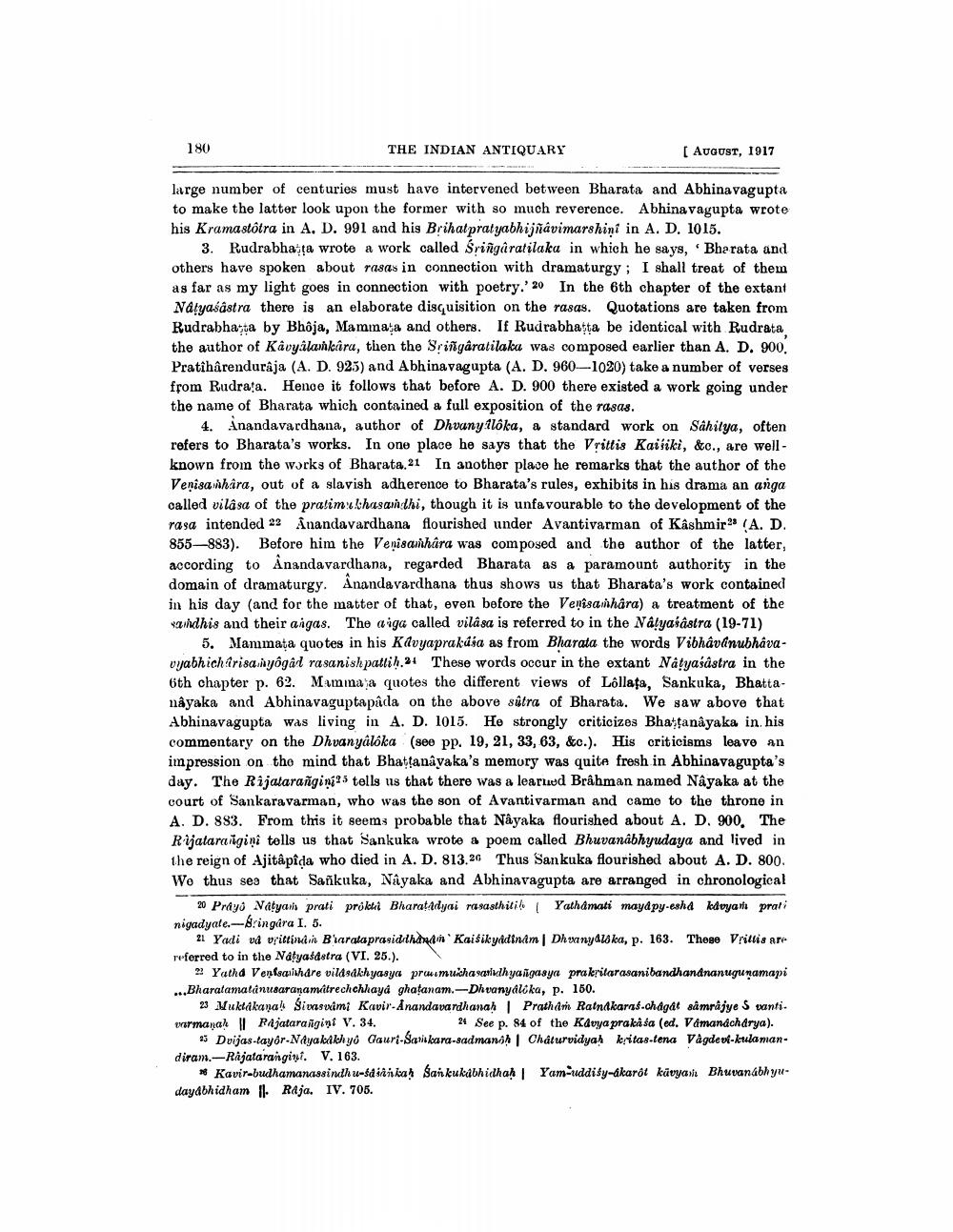________________
180
THE INDIAN ANTIQUARY
August, 1917
large number of centuries must have intervened between Bharata and Abhinavagupta to make the latter look upon the former with so much reverence. Abhina vagupta wrote his Kramastôtra in A. D. 991 and his Brihatpratyabhijñavimarshini in A. D. 1015.
3. Rudrabha ta wrote a work called Sriñgâratilaka in which he says, Bherata and others have spoken about rasas in connection with dramaturgy; I shall treat of them as far as my light goes in connection with poetry.' 20 In the 6th chapter of the extant Natyaśāstra there is an elaborate disquisition on the rasas. Quotations are taken from Rudrabha ta by Bhôja, Mammaa and others. If Rudrabhatta be identical with Rudrata the author of Kavyalahkaru, then the Srisgaratilaka was composed earlier than A. D. 900. Pratibârendurâja (A. D. 925) and Abhinavagupta (A. D. 960-1020) take a number of verses from Rudrata. Hence it follows that before A. D. 900 there existed a work going under the name of Bharata which contained a full exposition of the rasas.
4. Anandavardhana, author of Dhvanyalóka, a standard work on Sahitya, often refers to Bharata's works. In one place he says that the Vittis Kaifiki, &c., are wellknown from the works of Bharata 21 In another place he remarks that the author of the Venisa hâra, out of a slavish adherence to Bharata's rules, exhibits in his drama an anga called vilâ sa of the pratimukhasandhi, though it is unfavourable to the development of the rasa intended 22 Ânandavardhana flourished under Avantivarman of Kashmir” (A. D. 855-883). Before him the Venisaihara was composed and the author of the latter, according to Anandavardhana, regarded Bharata as a paramount authority in the domain of dramaturgy. Ananda vardhana thus shows us that Bharata's work contained in his day (and for the matter of that, even before the Venisa shara) a treatment of the vandhis and their aigas. The aiga called vilása is referred to in the Nályaiastra (19-71)
5. Mammata quotes in his Kavyaprakása as from Bharata the words Vibhavanubhavavyabhich arisa nyôgârl rasanish patlih.24 These words occur in the extant Natyasastra in the 6th chapter p. 62. Mama a quotes the different views of Lollata, Sankuka, Bhattanayaka and Abhinavaguptapada on the above sutra of Bharata. We saw above that Abhinavagupta was living in A. D. 1015. He strongly criticizes Bhattanayaka in his commentary on the Dhvanyalóka (see pp. 19, 21, 33, 63, &c.). His criticisms leave an impression on the mind that Bhattanayaka's memory was quite fresh in Abhinavagupta's day. The Rijatarañginias tells us that there was a learuud Brahman named Nayaka at the court of Sankaravarman, who was the son of Avantivarman and came to the throne in A. D. 883. From this it seems probable that Nayaka flourished about A. D. 900. The Rijataraiigini tolls us that Sankuka wrote a poem called Bhuvanabhyudaya and lived in the reign of Ajitâpida who died in A. D. 813.26 Thus Sankuka flourished about A. D. 800. We thus see that Sankuka, Nayaka and Abhinavagupta are arranged in chronological
20 Prayó Natyam prati prokti Bharatadyai rasasthitih | Yathamati mayapy-esha kdvyari prati nigadyate.-Singara I. 5.
21 Yadi vd vrittimiin Brarataprasidthdrain Kaisikyadinam Dhwany dla ka, p. 163. These Villis are referred to in the Natyasastra (VI. 25.).
» Yatha Venfsaithare vildsakhyasya pruimuchasarlıdhyañgasya prakritarasanibandhandnanugunamapi ...Bharatamatanusaranamatrechchhaya ghatanam. -Dhvanyalóka, p. 160.
23 Muktákana! Simsvimi Kavir- Anandavardhanah | Pratham Ratnakaras-chagát sâmrajye S vanti. varmanah | Pijatarangiņi V. 34.
24 See p. 84 of the Kdvya prakasa (ed. Vamanacharya). 25 Dvijas-tayor-Nayakakhyó Gauri-Sarikara-sadmanah | Chaturvidyah kritas-tena Vågdeut-kulamandiram.-Rajatarangini. V. 163.
Kavir-budhamanassindhu-bdian kah Sankukábhidhah | Yam-uddisy-karot kävya i Bhuvanabhyudayabhidham | Raja. IV. 705.




